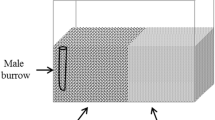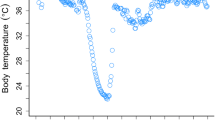Summary
In the Namib Desert dunes, the web of Seothyra sp. (Eresidae) comprises sticky silk lining the edges of a horizontal mat on the sand surface. The spider sits in a silk-lined burrow attached to the mat. Arthropods become entangled in the sticky silk of the mat and are attacked and pulled into the burrow by the spider. We investigated the influence of sand surface temperature on the activity of spiders during the summer. We determined the range of thermal conditions encountered by spiders, their temperature tolerance and the influence of temperature on foraging activity and prey handling behavior. The environmental temperatures available to Seothyra vary from 17–33° C at the coolest time of day to 33–73° C at the hottest. When prevented from retreating into burrows, spiders showed signs of thermal stress at about 49° C, whereas unrestrained spiders continued to forage at web temperatures above 65° C by moving between the hot surface mat and the cooler burrow. Spiders responded quicker to prey stimuli during the hot hours of the day and completed prey capture sequences in significantly less time at surface temperatures above 49° C than below. Furthermore, captured arthropods succumbed more quickly at high surface temperatures. Our study supports the hypothesis that web design and thermoregulatory behaviors enable Seothyra to hunt under extreme thermal conditions.
Similar content being viewed by others
References
Casey TM (1981) Behavioral mechanisms of thermoregulation. In: Heinrich B (ed) Insect Thermoregulation. John Wiley, New York, pp 79–114
Cloudsley-Thompson JL (1982) Desert adaptations in spiders. Sci Rev Arid Zone Res 1:1–14
Crawford CS (1981) The Biology of Desert Invertebrates. Springer, Berlin Heidelberg New York
Crawford CS, Seely MK (1987) Assemblages of surface-active arthropods in the Namib dunefield and associated habitats. Rev Zool Afr 101:397–421
Curtis BA (1985a) Activity of the Namib Desert dune ant, Camponotus detritus. S Afr J Zool 20:41–48
Curtis BA (1985b) Temperature tolerances in the Namib Desert dune ant, Camponotus detritus. J Insect Physiol 31:463–466
Curtis BA (1985c) Observations on the natural history and behaviour of the dune ant, Camponotus detritus Emery, in the central Namib Desert. Madoqua 14:279–289
Hamilton WJ III (1975) Coloration and its thermal consequences for diurnal desert insects. In: Hadley NF (ed) Environmental Physiology of Desert Organisms. Dewden, Huchinson and Ross, Stroudburg, PA, pp 67–89
Henwood K (1975) A field-tested thermoregulation model for two diurnal Namib Desert tenebrionid beetles. Ecology 56:1329–1342
Humphreys WF (1974) Behavioural thermoregulation in a wolf spider. Nature (Lond) 251:502–503
Humphreys WF (1978) The thermal biology of Geolycosa godeffroyi and other burrow inhabiting Lycosidae (Araneae) in Australia. Oecologia 31:319–347
Humphreys WF (1987) Behavioural temperature regulation. In: Nentwig W (ed), Ecophysiology of Spiders. Springer, Berlin Heidelberg New York, pp 56–65
Lighton JRB, Bartholomew GA, Feener DH (1987) Energetics of locomotion and load carriage and a model of the energy cost of foraging in the leaf-cutting ant Atta colombica Guer. Physiol Zool 60:524–537
Main BY (1982) Adaptations to arid habitats by mygalomorph spiders. In: Barker WR and Greenslade PJM, Evolution of the Flora and Fauna of Arid Australia, Peacock Publications, Frewville, South Australia, pp 273–283
Marsh AC (1985a) Thermal responses and temperature tolerance in a diurnal desert ant, Ocymyrmex barbiger. Physiol Zool 58:629–636
Marsh AC (1985b) Microclimatic factors influencing foraging patterns and success of the thermophilic desert ant, Ocymyrmex barbiger. Insectes Sociaux 32:286–296
Marsh AC (1987) Thermal responses and temperature tolerance of a desert ant-lion larva. J Therm Biol 12:295–300
Moeur JE, Eriksen CH (1972) Metabolic responses to temperature of a desert spider, Lycosa (Pardosa) carolinensis (Lycosidae). Physiol Zool 45:290–301
Norgaard E (1951) On the ecology of two lycosid spiders (Pirata piraticus and Lycosa pullata) from a Danish sphagnum bog. Oikos 3:1–21
Pulz R (1987) Thermal and water relations. In: Nentwig W (ed), Ecophysiology of Spiders. Springer, Berlin Heidelberg New York, pp 26–55
Purcell WF (1903) New Arachnida collected by Mr. S. C. Conwright Schreiner at Hanover, Cape Colony. Ann S Afr Mus 3(1):13–40
Riechert SJ, Tracy CR (1975) Thermal balance and prey availability: bases for a model relating web-site characteristics to spider reproductive success. Ecology 56:265–284
Seymour RS, Vinegar A (1973) Thermal relations, water loss and oxygen consumption of a North American tarantula. Comp Biochem Physiol 44A:83–96
Shachak M, Brand S (1983) The relationship between sit-and-wait foraging strategy and dispersal in the desert scorpion, Scorpio maurus palmatus. Oecologia 63:371–377
Sokal RR, Rohlf FJ (1981) Biometry. Second Edition. WH Freeman and Company, New York
Willmer PG (1982) Microclimate and the environmental physiology of insects. Adv Insect Physiol 16:1–57
Author information
Authors and Affiliations
Rights and permissions
About this article
Cite this article
Lubin, Y.D., Henschel, J.R. Foraging at the thermal limit: burrowing spiders (Seothyra, Eresidae) in the Namib desert dunes. Oecologia 84, 461–467 (1990). https://doi.org/10.1007/BF00328161
Received:
Accepted:
Issue Date:
DOI: https://doi.org/10.1007/BF00328161




